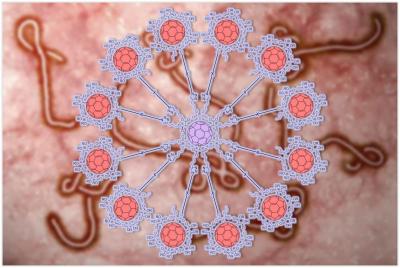A discovery which may lead to the elimination of Ebola infections was published in Nature Chemistry a few days ago. The investigators reported that giant fullerene system inhibits the cell infection by an artificial Ebola virus.
Ebola virus infection starts with attachment of the virus to receptor DC-SIGN on dendritic cells, one of the most important cells of our immune response. These cells detect pathogens and are responsible for providing early warning to trigger the reaction of the immune system. According to Rafael Delgado, a researcher at the Hospital 12 de Octubre, Universidad Complutense de Madrid (UCM) and one of the co-authors of the publication, in case of Ebola virus this receptor acts as a point of entry for the virus into the body rather than playing a defensive role.
The new study shows that molecule which consists of 12 fullerenes to which 10 sugars are attached and a fullerene core that forms a globular superstructure with 120 peripheral sugars on the surface, was efficient in blocking the receptor DC-SIGN and thus preventing virus invasion into the cells and subsequent cell infection. Nazario Martín, Professor of Organic Chemistry in the UCM and the main author of this study explains that fullerenes are hollow cages exclusively formed by carbon atoms. In this study, researchers have used the C60 fullerene which consists of 60 carbon atoms and has the shape of truncated icosahedron, similar to a soccer ball. The icosahedral structure is covered by mannose, the same type of sugar that Ebola has on its surface. This sugar is relatively rare in human cells but very characteristic for Ebola virus.
Experiments were made using artificial Ebola virus expressing one of its proteins, envelop glycoprotein GP1, which is responsible for the virus entry into the cells. This artificial virus only infects cells but cannot replicate inside them. One of the co-authors, Rafael Delgado, reminds that this is just a first step and investigation using this giant molecules should be made with true Ebola virus. Moreover animal models such as mice should be included before any conclusions can be made. Even though this research is still at a very early stage it gives a new hope for the future treatments not only for Ebola infections but also for other infections that we cannot treat properly.
You can read about some other attempts to prevent Ebola infection here.
By Katarina Kovac, PhD, BioSistemika LLC












